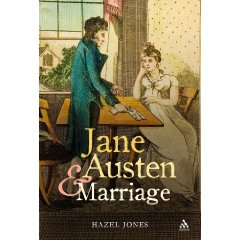A compendium of Austen characters, relatives, friends and neighbors highlight Hazel Jones’ look into the subject of Jane Austen & Marriage. As the book proceeds through the steps of acquaintance, engagement, marriage, and even separation, Jones fleshes out the interaction between man and woman in nineteenth-century Britain. Illustrative excerpts from the novels and primary research sources provide a well-rounded, informative basis for her walk up the garden path and down the aisle.
Examining, chapter by chapter, components of relationships, the book begins with “Choice.” We learn that both sexes could, in fact, choose to opt out of the game. Concerns over continual childbearing and the risk of death, some women made the choice to remain single. Due in part to the shortage of men on the homefront (thanks to the Napoleonic Wars), others found the choice made for them. Men in a position to marry, on the other hand, sometimes thought about their incomes and the demands a growing family would make upon it before contemplating marriage. Therefore, the idea of choice concerns much more than the selection of a life-partner.
Jones’ next chapter brings up the point of how “the question” might actually be popped: in person, via letter, via an intermediary. Sadly, she finds little — in conduct literature or letters — to indicate the “traditional” down on bended knee type of proposal. Few readers will have delved into letters and diaries from this period; the timid suitors who chose the letter/intermediary route might therefore come as a pleasant surprise.
Discussions of conduct books point up the idea that such items existed because no one conducted themselves as they “ought” to have done. By looking at the paramount examples valued by these conduct books and juxtaposing them with the reality of relationships recorded in letters, diaries, and biographies, readers realize just how much Austen’s novels were signs of their times.
Two minor points that the writer and/or editor should have attended to are the spellings of Longbourne and Lizzie in place of the standard Longbourn and Lizzy. The fault may lie with Jones’ use of the Penguin edition of Austen novels.
Jane Austen & Marriage may supply few totally new revelations, but as a compendium of love, courtship, and marriage in Austen’s era (as well as family), Jones has provided a particularly useful book. Readers will welcome the author’s friendly style of writing as well as her insight into women like Lydia Bennet, Anne Elliot, and Marianne Dashwood. Highly recommended.
Four full inkwells.
(for more on this book, see Two Teens in the Time of Austen, my research blog)


Pingback: For Better, For Worse « Two Teens in the Time of Austen
Great news! Thanks for the thoughtful review Kelly. Since Austen’s novels revolve around marriage, I am so surprised that this is one of the first books dedicted to a subject that was so critical to the success and happiness of so many Regency relationships.
LikeLike
Dear Laurel Ann – it is indeed with high praise that I recommend this book. Its subject is fresh, and its handling is very well done (a pleasing change over some books).
Working on an article about Elizabeth Darcy’s wedding journey, I was just re-reading the chapter on the wedding ceremony (“Where N Takes M, For Better, For Worse”) and am truly amazed to see Jones moving from the marriage of Jane Cooper (Austen’s cousin) to a discussion of the marriage ceremony, to a discussion of the giving and receiving of wedding rings, to a discussion of the Marriage Act of 1753. Well, you see where all this is leading: Without being pedantic, Jones imparts information, drawing the reader into the discussion through a wonderful mixture of the real (Cooper) and the novel (Lydia Wickham flashing her wedding ring as she returns to Longbourn).
Would LOVE to hear from other readers. I agree with Laurel Ann: this book-length look at marriage and its surrounding rituals was long in coming; thank goodness it was worth the wait!
LikeLike
Kerri Spennicchia – JASNA’s Austen “clipping” maven – sent around the Times Literary Supplement review of this book. I attach it for others to read; see my research blog.
LikeLike
Pingback: It’s Arrived! « Two Teens in the Time of Austen
Pingback: Jane Austen’s Transatlantic Sister | Two Teens in the Time of Austen